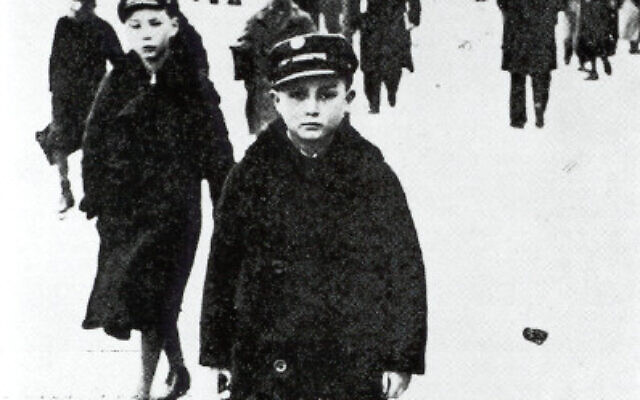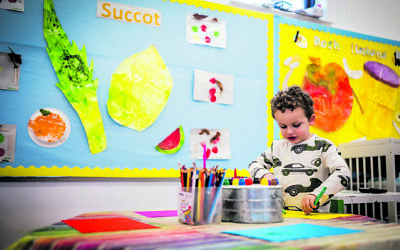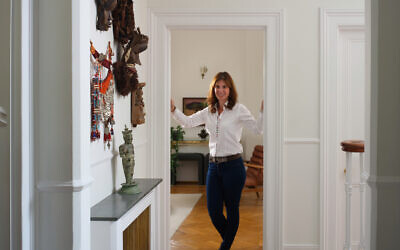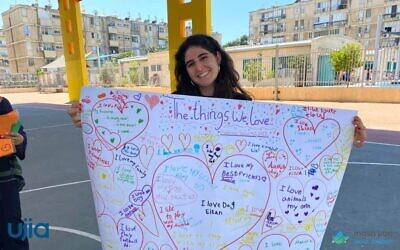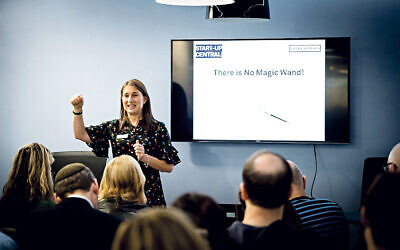The new Anne Frank? Diary of teenager in Vilna Ghetto made available to read online
YIVO exhibition demonstrates 'importance of youth voices in historical narratives'
Jenni Frazer is a freelance journalist
Eighty years ago, in July 1944, Vilnius, the capital city of Lithuania, was liberated from its Nazi occupation by the Soviet army.
Teenager Sore (Sarah) Voloshin was the sole survivor of her 50-strong family. Sore had fled mass Nazi shootings in the Ponar pits, just outside Vilnius, and joined the partisans in the surrounding forests.
After liberation Sore, with her friend Feyge, climbed back into the attic of a house in Dysnos Street in Vilnius, where her family had been hiding before being rounded up in September 1943. And there on the attic floor was the 200-page diary of her brilliant cousin Yitskhok Rudashevski, who had been shot dead in Ponar.
Sore scooped up the diary, written in Yiddish, together with what family photographs she could salvage, and gave it to the writer Abraham Sutzkever, who briefly displayed it in a post-war museum of Jewish artefacts, before realising that it and other Jewish Holocaust material were unlikely to survive the Soviet rule in Lithuania.
The diary — together with thousands of pieces of written material — was sent to the YIVO Institute for Jewish Research in New York, where it remains today.

On 17 July 2024 Yitskhok Rudashevski’s poignant diary of the Holocaust, as experienced in the Vilna Ghetto, came triumphantly to life. YIVO commissioned a new English translation, and the diary is the focus of a state-of-the-art online exhibition, free to a global audience.
Arguably the most famous Holocaust diary is that of another teenager, Anne Frank. But Anne, just two years younger than Yitskhok, was able only to write about life in the annexe in Amsterdam where she and her family, together with other Jews, were hiding from the Nazis. Yitskhok chronicled living conditions in the Vilna Ghetto and his thoughts about his family, his school, his friends and his keen sense of political developments as the Nazis swept across Europe.
When Yitskhok was born on 10 December 1927, Vilna was part of Poland. He was the only child of Eliyahu, a typesetter for the Vilner Tog, a Jewish daily paper, and his wife Rosa, a seamstress. The family — including Yitskhok’s maternal grandmother — lived in a small flat in the city.

We learn from the exhibition that Yitskhok was a clever and involved school student, and that “Plenty of Jews in Vilna were religious; Yitskhok Rudashevski was just not one of them. However, his family still considered itself culturally Jewish”.
Yitskhok and his cousin Sore often walked to school together, discussing their mutual love of Yiddish writers. He is described as “a committed young Marxist”, who took great interest in world politics. His father told him about stories he was working on at the newspaper, and Yitskhok read books and articles to help him stay informed. He heard news about what the Nazis were doing in Germany, and worried that soon their actions would impact his family and community.
The first diary entry was on 14 June 1941, when he was 13, though he may have started recording his thoughts earlier. But on that day, he wrote: “I observe the empty, sad streets. A Lithuanian with a gun is standing in the street. I begin to grasp the vile treason of the Lithuanians: they shot the Red Army men in the back. They are going along with the Nazi bandits. The Red Army will return, and you will pay dearly, traitor! We will outlive you — that is our answer to the Lithuanian soldier with the Haenel gun. A motorcycle drives through the early-morning street: a gray, angular helmet, glasses, an overcoat and a gun. Unfortunately, I have spotted the first soldier of the German army of occupation. His helmet flashes evil and cold.”
The day after this diary entry, the Nazis began imposing martial law in Vilnius, and local Lithuanians and police agreed to help them.

The YIVO curator of the exhibition, Karolina Ziulkoski, says that Yitskhok wrote about what happened between June and December 1941 in retrospect. “Then there is a gap, and he began writing again from September 1942 until April 1943” — though he and his family were probably not killed until late September or early October 1943.
Yitskhok recorded: “Weeks go by. I am cut off from the summer, from my surroundings, chained to the house, to the courtyard. I don’t see any of my friends. There is no contact at all among the group. Everyone is preoccupied with his own day-to-day worries. Jews are humiliated and exploited. We have to stand in long lines to obtain bread and other foodstuffs. Jews are pushed out of them. Germans come up to the queues and throw the Jews out. Jews receive less food than the Aryans. Our life is a life of helpless fear. Our day is without a future.”
The Nazi grip on the Jews of Vilnius becomes tighter and tighter, with new draconian restrictions announced daily.
Yitskhok wrote: “It is dawn. I look out of the window and I see the first Vilna Jews with patches. It pained me to see how people are staring at them. The big pieces of yellow material on their packs burn inside me. For a long time, I couldn’t put on the patches. It felt like a hump and two frogs were on me. I felt ashamed to appear with them in the street, not because I am a Jew, but because I am ashamed of what has been done to us. I was ashamed of our helplessness… they will hang patches on us from head to toe, and we can do nothing about it. It pained me that I could see no way out.”
On 6 September 1941 the Vilna Jews were herded into a ghetto, a few tiny streets crammed with people. “I locate my parents and here we are, in our ghetto home. It is evening, very dark and rainy. The little streets Rudnitsker, Shavler, Yatkever, Shpitol [Hospital] Street, and Disner, which make up the ghetto, look like anthills. They teem with people”.
Because the Nazis kept changing the rules about valid documentation, the Rudashevski family was eventually forced to go into one of the hideouts set up by the ghetto inhabitants — the so-called “melinas”.

The family secreted itself in cramped conditions between two floors of a flat as the ghetto was cleared of inhabitants. Hundreds of people, wrote Yitskhok, were taken to Ponar. “Ponar — that word is written in blood. Ponar — the huge grave… a slaughterhouse for thousands of Jews. The Ponar area is saturated with Jewish blood. Ponar is the same thing as a nightmare, a nightmare that has accompanied the gray thread of our ghetto-days. Ponar is passive death. The word contains the tragedy of our helplessness. No! We will not go to Ponar.”
Tragically, however, Ponar was indeed Yitskhok’s fate. He stopped writing his diary on April 7 1943 and his cousin Sore later said that he spent his last months “quiet and depressed, not writing and barely speaking”.
In September 1943 the family, fearful of being caught in yet another “aktion”, or round-up, hid in another “melina”, this time in the attic of Dysnos Street, where they hoped to hole up until the Soviet army came to liberate Vilnius. They survived for 11 days in the attic until a person sent out for precious water was followed by the Nazis, the melina was discovered, and everyone was sent to prison. Days later Eliyahu, Rosa, and 16-year-old Yitskhok were taken to Ponar and shot dead.
YIVO says that the teenager’s diary provides “intimate insights into daily life, cultural resistance, and moral choices faced by those in the ghetto. The exhibition also ties into broader themes of preserving heritage and the importance of youth voices in historical narratives”.
Yitskhok Rudashevski: A Teenager’s Account of Life and Death in the Vilna Ghetto is available free of charge to the global public at

Thank you for helping to make Jewish News the leading source of news and opinion for the UK Jewish community. Today we're asking for your invaluable help to continue putting our community first in everything we do.
For as little as £5 a month you can help sustain the vital work we do in celebrating and standing up for Jewish life in Britain.
Jewish News holds our community together and keeps us connected. Like a synagogue, it’s where people turn to feel part of something bigger. It also proudly shows the rest of Britain the vibrancy and rich culture of modern Jewish life.
You can make a quick and easy one-off or monthly contribution of £5, £10, £20 or any other sum you’re comfortable with.
100% of your donation will help us continue celebrating our community, in all its dynamic diversity...
Engaging
Being a community platform means so much more than producing a newspaper and website. One of our proudest roles is media partnering with our invaluable charities to amplify the outstanding work they do to help us all.
Celebrating
There’s no shortage of oys in the world but Jewish News takes every opportunity to celebrate the joys too, through projects like Night of Heroes, 40 Under 40 and other compelling countdowns that make the community kvell with pride.
Pioneering
In the first collaboration between media outlets from different faiths, Jewish News worked with British Muslim TV and Church Times to produce a list of young activists leading the way on interfaith understanding.
Campaigning
Royal Mail issued a stamp honouring Holocaust hero Sir Nicholas Winton after a Jewish News campaign attracted more than 100,000 backers. Jewish Newsalso produces special editions of the paper highlighting pressing issues including mental health and Holocaust remembrance.
Easy access
In an age when news is readily accessible, Jewish News provides high-quality content free online and offline, removing any financial barriers to connecting people.
Voice of our community to wider society
The Jewish News team regularly appears on TV, radio and on the pages of the national press to comment on stories about the Jewish community. Easy access to the paper on the streets of London also means Jewish News provides an invaluable window into the community for the country at large.
We hope you agree all this is worth preserving.


